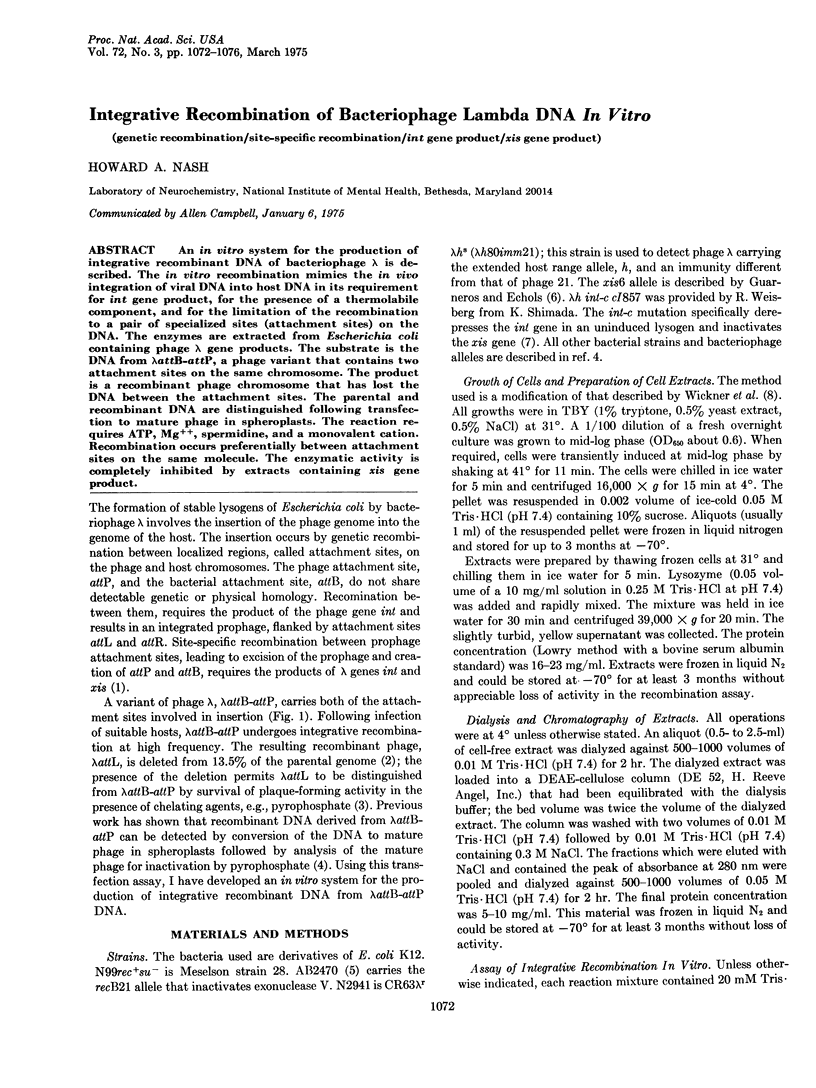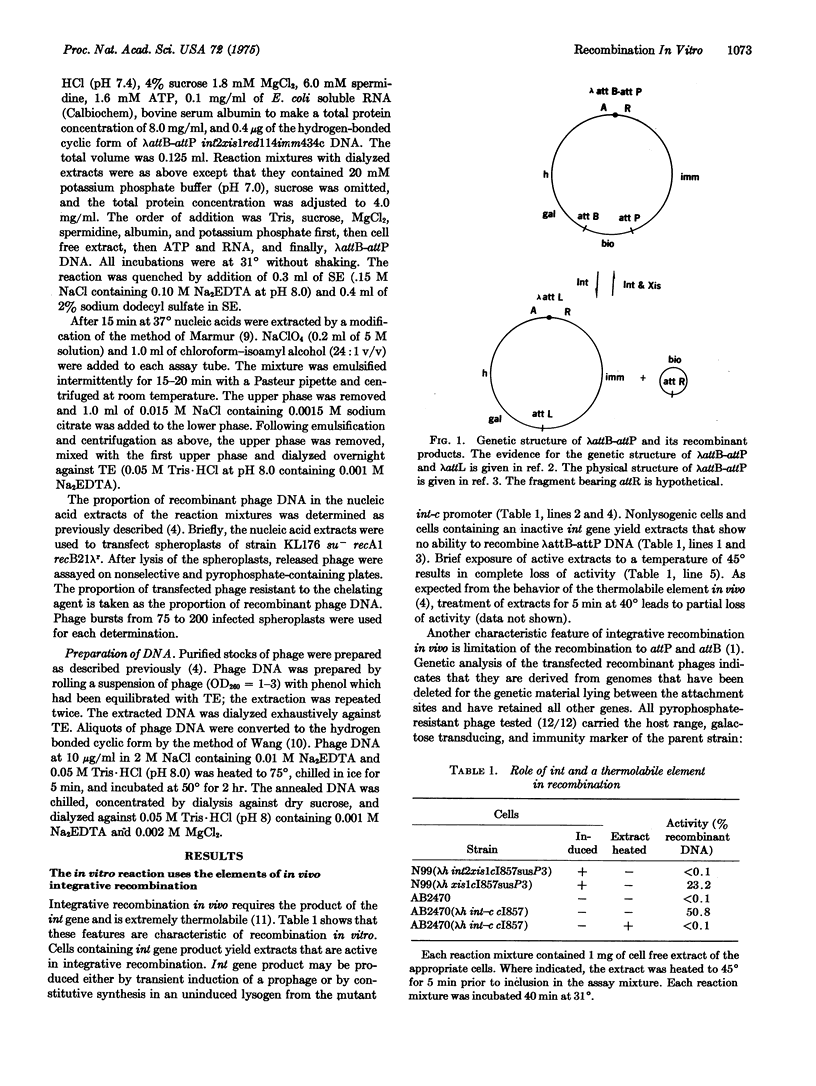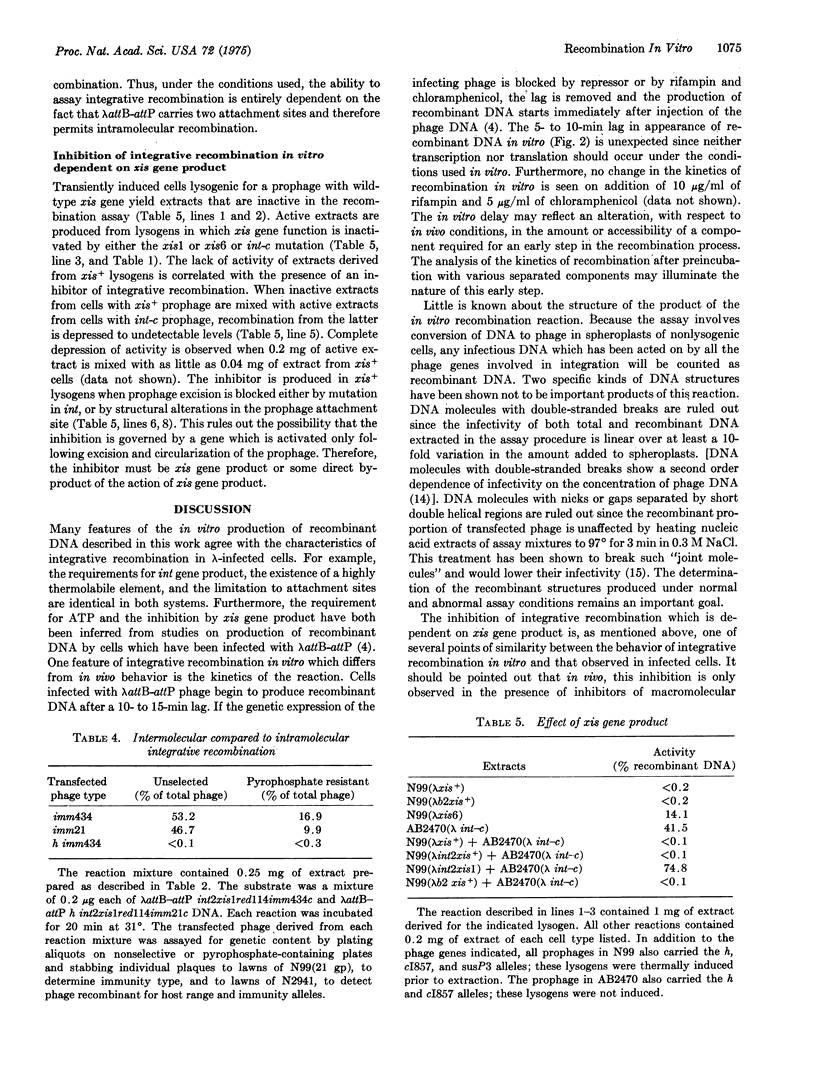Abstract
An in vitro system for the production of integrative recombinant DNA of bacteriophage lambda is described. The in vitro recombination mimics the in vivo integration of viral DNA into host DNA in its requirement for int gene product, for the presence of a thermolabile component, and for the limitation of the recombination to a pair of specialized sites (attachment sites) on the DNA. The enzymes are extracted from Escherichia coli containing phage lambda gene products. The substrate is the DNA from lambda-attB-attP, a phage variant that contains two attachment sites on the same chromosome. The product is a recombinant phage chromosome that has lost the DNA between the attachment sites. The parental and recombinant DNA are distinguished following transfection to mature phage in spheroplasts. The reaction requires ATP, Mg++, spermidine, and a monovalent cation. Recombination occurs preferentially between attachment sites on the same molecule. The enzymatic activity is completely inhibited by extracts containing xis gene product.
Full text
PDF




Selected References
These references are in PubMed. This may not be the complete list of references from this article.
- Chang A. C., Cohen S. N. Genome construction between bacterial species in vitro: replication and expression of Staphylococcus plasmid genes in Escherichia coli. Proc Natl Acad Sci U S A. 1974 Apr;71(4):1030–1034. doi: 10.1073/pnas.71.4.1030. [DOI] [PMC free article] [PubMed] [Google Scholar]
- Clark A. J. The beginning of a genetic analysis of recombination proficiency. J Cell Physiol. 1967 Oct;70(2 Suppl):165–180. doi: 10.1002/jcp.1040700412. [DOI] [PubMed] [Google Scholar]
- Guarneros G., Echols H. New mutants of bacteriophage lambda with a specific defect in excision from the host chromosome. J Mol Biol. 1970 Feb 14;47(3):565–574. doi: 10.1016/0022-2836(70)90323-2. [DOI] [PubMed] [Google Scholar]
- Guarneros G., Echols H. Thermal asymmetry of site-specific recombination by bacteriophage lambda. Virology. 1973 Mar;52(1):30–38. doi: 10.1016/0042-6822(73)90395-4. [DOI] [PubMed] [Google Scholar]
- Hershfield V., Boyer H. W., Yanofsky C., Lovett M. A., Helinski D. R. Plasmid ColEl as a molecular vehicle for cloning and amplification of DNA. Proc Natl Acad Sci U S A. 1974 Sep;71(9):3455–3459. doi: 10.1073/pnas.71.9.3455. [DOI] [PMC free article] [PubMed] [Google Scholar]
- Nash H. A. Integrative recombination in bacteriophage lambda: analysis of recombinant DNA. J Mol Biol. 1975 Feb 5;91(4):501–514. doi: 10.1016/0022-2836(75)90276-4. [DOI] [PubMed] [Google Scholar]
- Nash H. A. LambdaattB-attP, a lambda derivative containing both sites involved in integrative recombination. Virology. 1974 Jan;57(1):207–216. doi: 10.1016/0042-6822(74)90121-4. [DOI] [PubMed] [Google Scholar]
- Parkinson J. S., Huskey R. J. Deletion mutants of bacteriophage lambda. I. Isolation and initial characterization. J Mol Biol. 1971 Mar 14;56(2):369–384. doi: 10.1016/0022-2836(71)90471-2. [DOI] [PubMed] [Google Scholar]
- Shimada K., Campbell A. Int-constitutive mutants of bacteriophage lambda. Proc Natl Acad Sci U S A. 1974 Jan;71(1):237–241. doi: 10.1073/pnas.71.1.237. [DOI] [PMC free article] [PubMed] [Google Scholar]
- Suelter C. H. Enzymes activated by monovalent cations. Science. 1970 May 15;168(3933):789–795. doi: 10.1126/science.168.3933.789. [DOI] [PubMed] [Google Scholar]
- Syvanen M. In vitro genetic recombination of bacteriophage lambda. Proc Natl Acad Sci U S A. 1974 Jun;71(6):2496–2499. doi: 10.1073/pnas.71.6.2496. [DOI] [PMC free article] [PubMed] [Google Scholar]
- Wackernagel W., Radding C. M. Formation in vitro of infective joint molecules of lambda DNA by T4 gene-32 protein. Proc Natl Acad Sci U S A. 1974 Feb;71(2):431–435. doi: 10.1073/pnas.71.2.431. [DOI] [PMC free article] [PubMed] [Google Scholar]
- Wackernagel W., Radding C. M. Transfection by half molecules and inverted molecules of lambda DNA: requirement for exo and -promoted recombination. Virology. 1973 Apr;52(2):425–432. doi: 10.1016/0042-6822(73)90337-1. [DOI] [PubMed] [Google Scholar]
- Wickner W., Brutlag D., Schekman R., Kornberg A. RNA synthesis initiates in vitro conversion of M13 DNA to its replicative form. Proc Natl Acad Sci U S A. 1972 Apr;69(4):965–969. doi: 10.1073/pnas.69.4.965. [DOI] [PMC free article] [PubMed] [Google Scholar]


